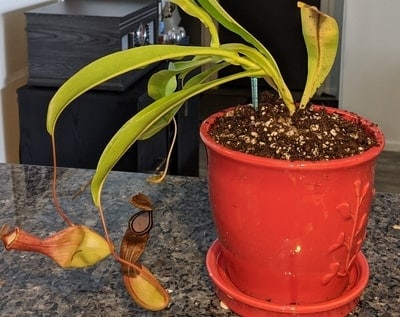When I first bought a pitcher plant, I was very worried about not caring for it properly and killing it. Pitcher plants require specific care instructions to thrive. After some time, I learned that growing Pitcher plants is a challenge, but can be done by following these instructions:
| Care Consideration | Recommendation |
|---|---|
| Lighting Requirement: | More than 10 hours of light exposure through natural or artificial light. |
| Watering Requirements: | Only employ distilled water, rainwater, or reverse osmosis water. The soil must be humid at all times. Bog gardens are suitable options. |
| Soil: | Employ nutrient-free soil: A mixture of peat moss or sphagnum moss and perlite or silica sand. |
| Temperature: | Common temperature range during the growing season: 60 – 80 F (15 – 27 C) |
| Humidity: | > 50% humidity level is recommended |
| Trimming: | Occasionally trim dried up leaves and flowers. |
| Feeding: | Pitcher plants capture bugs on their own. There is no need to feed the plant manually. |
| Fertilizers: | Not required. |
| Pots: | Employ plastic, glazed ceramic, or glass pots with drainage. |
| Repotting: | Repot once a year to promote growth. |
| Dormancy: | Some pitcher plant varieties require dormancy. |
| Outdoor vs Indoor growth: | Can be grown in both outdoor and indoor environments |
You can download a pitcher plant care sheet by clicking the link below. The care sheet is only a summary, make sure to read this article and get all the details.
Pitcher plants are an exceptionally beautiful and interesting family of plants to grow and care for. The very nature of a carnivorous plant begs your attention, and they are interesting to watch as they grow and feed. However, they can be considered to have a certain level of difficulty in growing, so they aren’t recommended for the beginning gardener.
Below, you’ll find a comprehensive breakdown of the best way to care for your pitcher plants in both indoor and outdoor growth methods. Read thoroughly to ensure success at growing pitcher plants.
Lighting Requirements for Pitcher Plants
Pitcher plants require very sunny locations to grow and thrive. This is one of the main reasons that they aren’t recommended for indoor growth. If you are planting your pitcher plant outdoors, be sure that it is going to receive full sunlight for several hours per day.
Pitcher plants require at least 10 hours of light to be healthy. Pitcher plants that don’t receive enough sunlight will be both pale in color and weak in their growth. A sure way to kill a pitcher plant is to plant it in an area where it doesn’t receive the required hours of direct sunlight every day.
If you’re going to attempt indoor growth with your pitcher plant, it’s very important to read the care tag that came with your plant carefully. Some pitcher plants won’t receive adequate sunlight indoors and will require an additional lighting source, such as artificial plant lighting. Other types of pitcher plants will need less direct sunlight, and their leaves could actually scorch or brown if you allow it to receive too much sunlight.
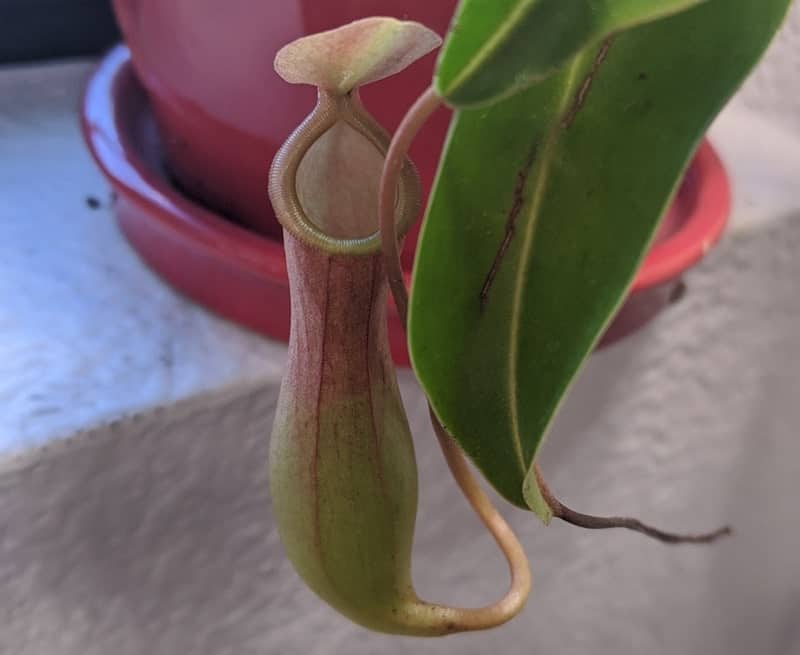
Healthy pitcher plants produce bright color pitchers ready to capture prey!
Carnivorous Plant Soil for Pitcher Plants
In their natural setting, pitcher plants will be found in low nitrogen soils and other nutrient-poor soils. They also grow best in soggy soils that don’t drain completely for most of the year.
The cool thing about pitcher plants is the fact that they have adapted to overcome poor soil quality with their carnivorous nature. What nutrients they don’t receive from the soil, they simply receive from their prey insects and arthropods.
Perlite and sphagnum or peat moss blends work best for indoor and outdoor Pitcher plant growth. As long as the soil is a well-draining, low nutrient blend, it should do exceptionally well for pitcher plant growth.
Here are a few examples of suitable potting media blends:
- 4:1 or 2:1 ratio of peat moss and perlite
- 4:1 or 2:1 ratio of peat moss and silica sand
- 4:1 or 2:1 ratio of sphagnum moss and perlite
- 4:1 or 2:1 ratio of sphagnum moss and silica sand
Perlite and silica sand are both key elements to promote aeration and drainage in the soil.
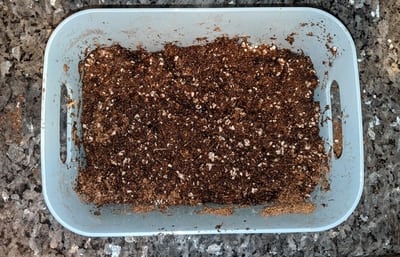
The Watering Process
Watering pitcher plants can be a tricky scenario (here is a guide on how to water them to the perfect level). (here is a guide on how to water them to the perfect level).. This is due to the high humidity level necessary to grow a healthy pitcher plant, and the fact that the soil needs to stay humid at all times of the year, be it with indoor or outdoor growth of the pitcher plant.
Pitcher plants require consistently humid soil at all times. The soil should drain the excess water, but always remain moist.
In addition, there is a strict set of guidelines about the type of water that can be used for watering pitcher plants.
What Type Of Water Should I Use?
Rainwater is the absolute best water source for pitcher plants. Distilled water is your next best option.
Do not use bottled water or tap water to water your pitcher plants, as they are sensitive to the minerals and chemicals that are found in bottled water and tap water.
An important thing to remember is that the pot needs to be very well-draining because standing water in the pot will cause root rot that will kill your pitcher plant in a short period of time.
How Frequently Should I Water?
The frequency with which you water your pitcher plants, either outdoor or indoor grown, highly depends on the soil you’re growing them in. Never use a commercial potting soil mix to grow them, as it won’t have an acidity high enough to maintain healthy growth.
Pitcher plants are perennials that have a dormant winter period with no growth. The optimal type of environment for them is a bog environment, so it is important that the soil is moist enough, but not soggy. You should thoroughly drain the excess water from the pot after every watering. They must have damp soil at all times, though, in order to thrive.
If your pitcher plant is growing in the right amount of humidity, it will produce its own water after about 30 days. If you notice it is consistently dry, you need to move the pitcher plant to a more humid growth environment.
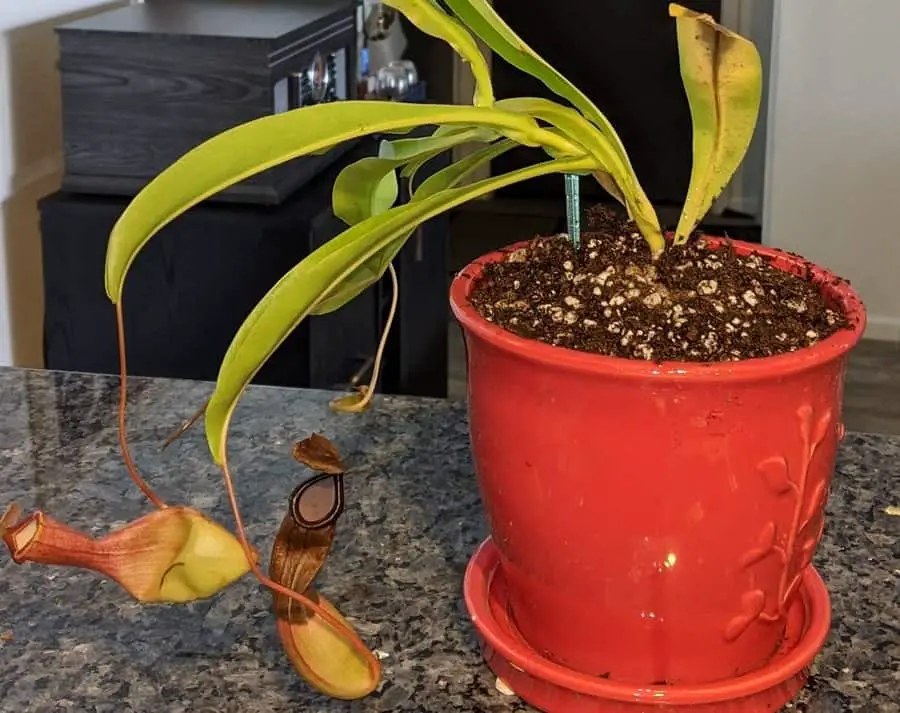
How Do You Feed A Pitcher Plant?
Pitcher plants are a genus of carnivorous plants that feed on insects and arthropods. Pitcher plants absorb the nutrients from their prey, which helps to make up for the lack of nutrients in the soil that they grow in.
Pitcher plants seek the additional food to derive nitrogen and potassium necessary for growth and maintaining itself during the winter dormancy period. However, they don’t require any more than an additional two or three feeding every few months.
A pitcher plant does not require you to feed it. They catch their own insects and arthropods for nutrition by using the mucilage that occurs naturally on their leaves to trap the insects and force them down the pitcher tube.
For a special treat for the carnivorous plant enthusiast, you can feed your pitcher plant using freeze-dried bloodworms, mealworms, flake fish food, or crickets. You can easily buy these food options in most pet stores.
How To Trim Your Pitcher Plant?
Pruning your carnivorous plant is a delicate task, and should be very carefully. After the plant has blossomed, you should take scissors and remove the bloom from its base. Also, you should trim off any part of the plant that looks yellow, brown, or wilted. This should also be done carefully with scissors in order to avoid damaging the plant.
You should take care to remove any dried up leaves. All of the decaying parts of the plant can be removed in order to ensure that new growth will occur.
You should also prune back the stems, blooms, and any untidy looking portions of the plant when you do the annual pruning.
When Is the Dormancy Period?
When winter conditions begin in your area, your carnivorous plant will begin to enter the dormancy period.
Nepenthes or tropical pitcher plants do not require dormancy. Other varieties of pitcher plants need a yearly dormancy period. Your plant does not need any sunlight during this period to survive. It should be placed in a basement or on a frost-free porch to sit out its winter dormancy period.
Dormancy during the winter is a natural mechanism that the pitcher plant has developed for protection from the harsh winter elements it is exposed to when growing in its natural environment.
Some of the carnivorous plants will grow winter leaves, as the Venus Flytrap does. Others simply drop their leaves in preparation for the winter dormancy period.
Your plant will be fine as long as it is properly stored during the winter months to avoid frost, and it will return to its active period with the spring weather. They also do not require nutrition from insects to survive in the winter dormancy period.
What Temperature Should Your Pitcher Plant Be Grown In?
Your carnivorous plant is actually really tolerant toward mild temperature changes.
Room temperature suits most species of pitcher plant just fine as long as there are no extreme highs and lows for the plant to contend with. Inside grown pitcher plants may experience a lack of humidity.
To increase the humidity for your Pitcher plant, you may want to run a humidifier in the room to ensure that it isn’t suffering from the dry, air-conditioned environment.
Ideally, you can grow your pitcher plants at a temperature range between 60 F and 80 F (15-27 C). However, some varieties of pitcher plants need different temperature spectra in order to thrive.
If you cannot ensure the proper temperatures by growing the pitcher plant outdoors, it is better to move it indoors to a steady and monitored climate so that it will survive any weather changes that are taking place.
What Is The Correct Humidity Level For Pitcher Plant Growth?
The pitcher plant is actually native to humid swamps and bogs, so they really do grow best in humid and wet conditions. However, they can develop fungus and mildew if they are left in a condition that invites water to sit and become stagnant on the plant or the roots.
A humidifier placed near the pitcher plant can really ensure that the correct humidity levels are maintained without inviting the growth of fungus, mold, or mildew.
If you can place the pitcher plant in an open terrarium that has a draft running through it, that is the ideal placement to maintain the correct humidity levels for your carnivorous plants.
Are Fertilizers Good for Pitcher Plants?
The use of fertilizers when you’re growing a pitcher plant isn’t actually necessary.
The best advice is not to use fertilizers on your carnivorous plants, as those same nutrients that are going to be supplied to the plant can be obtained from the insects and arthropods that they feed upon.
The only time that it is recommended to add fertilizer to a carnivorous plant is to maintain the soil, but it can be difficult to do with the correct dilution.
In the same way that the minerals in tap water can “burn” your carnivorous plant, fertilizers that aren’t diluted thoroughly enough will do the same thing to your plant. It is recommended if you must use fertilizer to employ a 1/10 dilution ratio, but it can still be quite tricky even then.
Should Pitcher Plants Be Repotted?
Yes, absolutely they can and must be repotted. Your carnivorous plant needs to be repotted into a larger container, or divided and repotted into several pots, every single year after the winter dormancy period. This is because the plant needs room for the roots to continue to grow, and also so it has room for extra nutrients necessary to the health and growth of the plant.
After the winter dormancy period, you should carefully divide your plant roots and stems and repot into multiple containers after you trim off the dead parts of the plant. They need to be repotted into a container with room for root growth, and with excellent drainage so that no root rot develops due to standing water in the potting soil. A 1 to 1 mix of peat moss and perlite is recommended for most Nepenthes plants, but you should always check the care tag on your plant to be sure that there isn’t a specialized blend recommended for your variety of carnivorous plant.
Pitcher Plant Varieties
Although many pitcher plants are native species to the southern United States, there are some types that do grow elsewhere in the world. They’re found thriving in nutrient-poor soils.
Before buying a pitcher plant, it is critical to choose the right variety to grow in your location. Each pitcher plant variety has specific growing requirements.
There are over 80 types of pitcher plants, and not all of them are suitable for outdoor growth, like those that are tropical in nature. It is wise to grow a pitcher plant variety that is native to your locale, as that will help the chances of the plant thriving in the natural environment.
For example, the purple pitcher plant, also known as the northern pitcher plant (sarracenia purpurea) is native to Canada but can be found growing naturally in places with temperate to cool climates without any problems.
The cobra pitcher plant (darlingtonia californica) is native to only extreme northern California and southern Oregon, and is incredibly difficult to grow outdoors in any other region because of the specific climate found in that area of the United States.
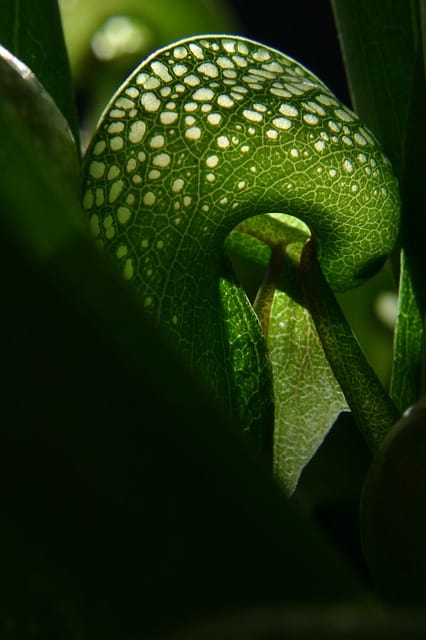
Species like the yellow pitcher plant (sarracenia flava), is much more forgiving of the climate it is growing in and can be found growing naturally in places like Texas and Florida. Certain varieties of pitcher plants, like the parrot pitcher plant, are actually on the endangered species list, and they shouldn’t be harvested from the wild or purchased from anyone because of this listing.
Indoor vs Outdoor Pitcher Plant Growing
The important thing to remember about growing pitcher plants outdoors is that the key to the plant thriving is site and soil. It absolutely matters what type of soil blend is being used in order to successfully grow carnivorous plants in any outdoor environment. It is also best if you select a pitcher plant that naturally grows in a similar climate to the climate in which you’re trying to grow it.
No rich, organic soil is needed to grow carnivorous plants in either indoor or outdoor capacity, and you should instead opt for a soil blend like a one-to-one ratio of peat moss and perlite. This is a well-draining and hearty blend that can support a healthy growth rate for a pitcher plant.
With indoor growth, it is important to remember that a pitcher plant can die if the humidity rate the plant needs to thrive isn’t achieved. When growing this type of plant indoors, it is often recommended to place a humidifier in the room so that the proper humidity levels are constantly maintained. This is especially important if they are inside a home with a central air conditioning system running, as this can quickly dry them out to the point of no longer being able to grow.
Just be sure that there are adequate amounts of sunlight if you are placing the pitcher plant either indoor or outdoor to grow, and also use the tray watering method in order to ensure that the soil stays moist enough that optimal growth can occur. If it seems as though the leaves are scorching, or turning yellow or brown, it is getting too much sunlight and should be moved to a less sunny location so that it doesn’t end up dying. Any burned or dried out leaves should be pruned off of the pitcher plant so that new growth can take place and the plant can continue to thrive and grow.
Where to Buy Pitcher Plants?
Be careful about purchasing carnivorous plants from garden centers or variety stores. Often, they are watered on the same cycle as other plants and the special conditions required for healthy growth in a carnivorous plant are not adhered to. This can be a deadly scenario for your pitcher plant and it could already be a very unhealthy plant by the time you purchase the plant and take it home.
The best places to buy pitcher plants are nurseries or greenhouses that specializes in the growth and care of carnivorous plant species. Check the plants’ conditions and ask about the care practices that they use for the plants to ensure that it has been properly cared for.
Also, be certain to check for a care tag in the plant before you purchase it. There are many different varieties of carnivorous plants, and that means that they have many different ways to be properly cared for. If you don’t have a care tag to advise you on the specialized type of care that you need to give to your pitcher plant, chances are that you will end up with an unhealthy or dead potted plant in a very short amount of time.
Be certain that you spend some time talking with the plant retailer, as they are often a wealth of knowledge about the plants that they carry, and can often give great advice about the care and growth of the plants you decide to purchase.


